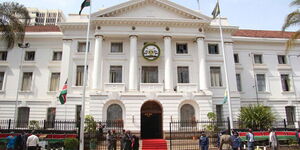The Shakahola massacre, one of the most horrifying events in Kenya’s recent history, was preventable.
A damning report released by the Commission on Administrative Justice, also known as the Office of the Ombudsman, has exposed the negligence of six government officials, directly implicating them in the deaths of 436 people.
The report, unveiled on Friday, August 30, reveals that police and administrative officers failed to act on numerous warnings, leading to the tragic events.
Why it matters: The number of deaths resulted in uproar. Kenyans wanted to know how such a massacre could take place and who dropped the ball and how. This report, offers the first official government report on the matter, providing crucial answers to questions about how the massacre, which took place over time, went unnoticed.
Dig dipper: The Ombudsman’s investigation, triggered by recommendations from a Senate Ad Hoc Committee, aimed to determine whether public officials had willfully neglected their duties, contributing to the Shakahola tragedy.
The findings are unequivocal: there was a gross dereliction of duty by officials from both the National Government Administration and the National Police Service, who ignored clear warnings and allowed the massacre to unfold.
Among those found culpable are Thuo Ngugi, the former Deputy County Commissioner for Malindi Sub-County, and Daniel Ntausi, the former Assistant County Commissioner for Langobaya Division.
The report also names Raymond Mcharo, the current Chief of Chakama Location, along with Senior Superintendent of Police Charles Kamau, the former Sub-County Criminal Investigations Officer for Malindi, Chief Inspector Hassan Hamara, the former Officer Commanding Station for Langobaya Police Station, and Sergeant Joseph Yator, a DCI officer in Malindi Sub-County.
These individuals, according to the Ombudsman, failed to take necessary actions despite receiving numerous reports about the illegal activities of Paul Mackenzie, the self-proclaimed pastor behind the massacre.
The investigation highlighted that reports regarding Mackenzie’s suspicious activities were made to Langobaya Police Station, the Chief’s office in Chakama, and various security committees between 2021 and 2023. Despite these warnings, the officials in question did nothing to prevent the tragedy.
Recommendations: The Ombudsman’s report recommends that the Principal Secretary for the State Department of Interior and the National Police Service Commission take immediate disciplinary action against the six individuals.
The Ombudsman has also directed the Directorate of Criminal Investigations to conduct thorough investigations into the reports filed at Langobaya Police Station, particularly those by Daniel Kitsao and Jackson Safari Katana.
These reports, filed in 2021 and 2022, could have prevented the massacre if acted upon. The DCI is expected to report back to the Ombudsman within six months on the steps taken.
Moreover, the report points to the need for systemic changes within the police and administrative services. It calls for enhanced surveillance, accountability, and coordination among the National Police Service and National Government Administrative Officers.
The Ombudsman has urged the Inspector General of Police to ensure that Langobaya Police Station is equipped with an official vehicle and that the offices of the Assistant County Commissioner for Langobaya and Chief of Chakama Location are provided with proper means of transport.
How things unfolded: The tragedy at Shakahola, which began with the discovery of malnourished and neglected children, quickly escalated into the unearthing of shallow graves and the rescue of survivors. Paul Mackenzie, who led the Good News International Church, had a history of legal troubles dating back to 2017.
His illegal activities, which included operating unregistered schools and promoting extremist ideologies, were well-known to local authorities. Yet, despite this, he was allowed to continue his operations, ultimately leading to the horrific events at Shakahola.
The report is a scathing indictment of the failures within Kenya’s law enforcement and administrative systems. It paints a picture of a country where those tasked with protecting citizens are often the very ones who allow tragedies to occur.
The Ombudsman’s recommendations are clear: the officials responsible must be held accountable, and systemic changes must be implemented to prevent such a tragedy from happening again.












